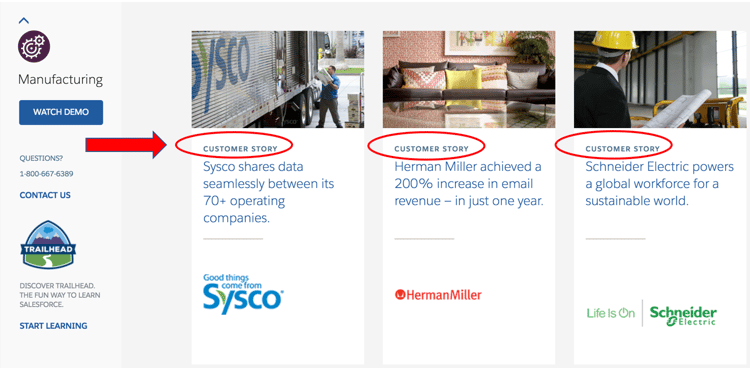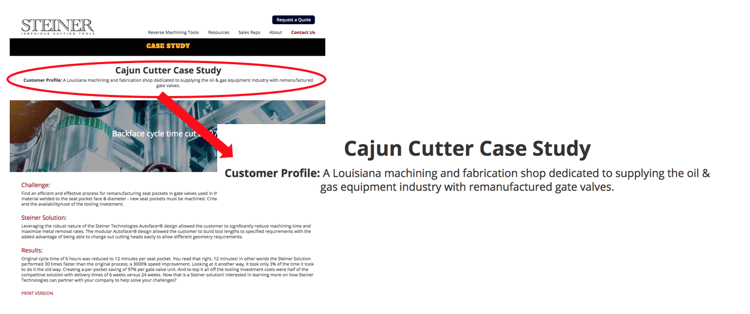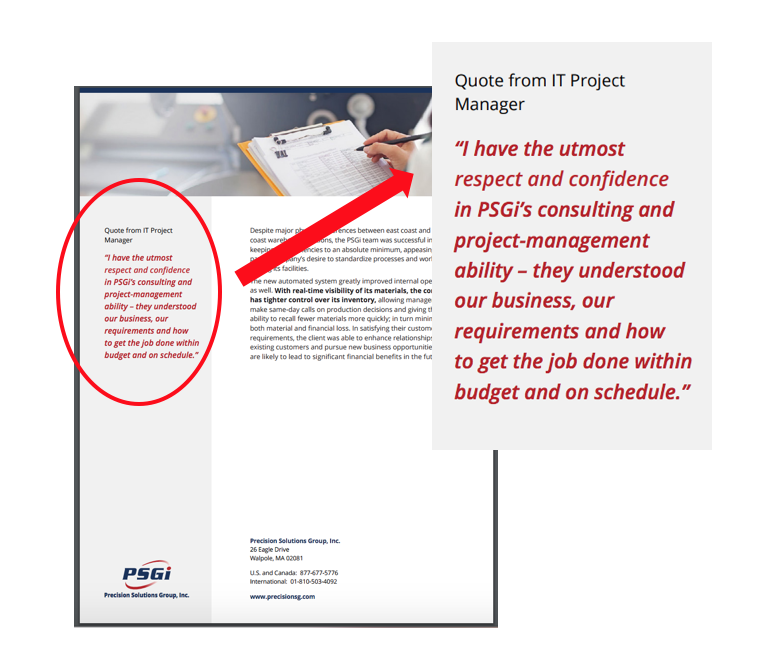Writing a good case study for a manufacturing audience takes more than just listing results. A convincing asset that builds trust and converts leads should include:

Dive into these five steps—with examples—to whip up a solid case study that sells buyers on your solution.
Content:
1. Start with a "Story” Mindset
Everyone loves a good story. That’s the reason storytelling marketing proves time and time again to be the secret sauce for so many aspects of your content strategy. Case studies make the storytelling recipe especially easy—after all, they truly are the stories of how you’ve helped clients in the past. In manufacturing marketing, that kind of narrative is often what sets you apart from competitors relying only on specs or features.
To make those stories compelling, start by thinking in terms of the simple arc narrative you learned about in grade school:
- Protagonist = your customer
- Villain = the problem they faced
- Conflict = the battle of overcoming that problem
- Hero = your manufacturing product or service
When you apply these writing principles, even in their most basic form, your readers are more inclined to read on in search of the happy ending.
Writing Tip: The mere suggestion of a “story” is engaging on any website. Consider swapping out the marketing-esque term “Case Studies” on your website with “Customer Stories,” as Salesforce does below.

2. Kick It Off with a Customer Profile
Right upfront, it’s helpful to offer a quick profile of the customer you helped. A sentence or two may be all you need to address the basics.
For example, which manufacturing sector are they in? Was it a small family-owned firm or a global giant? Setting the stage with a few basic details will help prospective clients understand the types of companies you’ve worked with and whether the manufacturing services you provided will work well for them, too.
3. Introduce the Challenge
What was the problem (or in most cases, multiple problems) that the customer was facing when they called you? In this section, you’ll want to talk about the main challenge and some of the customers’ pain points that it caused.
Here’s where you can throw in some plot-thickeners, too. Address any relevant circumstances that may have worsened the challenge at hand.
For example:
- Did a government regulation pose additional barriers to a company’s goal in achieving lower cost-per-unit in production?
- Was there a small budget or pressure to deliver results faster than usual—common drivers in manufacturing lead gen campaigns?
- Was the company dealing with equipment failures or supply chain disruptions that stalled production and compounded their original challenge?
Writing Tip: Think ahead to the solutions in the next section. The solution should answer all challenges mentioned here, so that will help guide your thinking in this step. Don’t overdo it with extraneous details that don’t apply to the solution you provided.

4. Spotlight the Solution
You’ve teed up the challenge. Now it’s time for the hero (you!) to shine. This is your opportunity to show readers a real-life example of how, specifically, your manufacturing product or service addressed each aspect of the challenge you’ve laid out.
Here’s where details matter most:
- Provide specifics about your company’s approach in assessing and implementing the solution.
- Surface all the ways in which your company’s unique differentiators as a company made it a success.
- Be sure to close the loop on any of the plot-thickeners you included, and explain how they lent themselves to success.
Writing Tip: Be honest about what went wrong, too! Manufacturing solutions are rarely implemented without ANY hitches, and your customers know this. Talking about hurdles that you encountered along the way and how you worked with the customer to resolve them is what can make a good case study great.
5. Make Quantifiable Results Your Happy Ending
How would your client measure the impact of the solution you provided? In this section, hard facts and figures should tie the bow on your narrative.
Here are a few compelling examples:
- How many hours did you put back into production time monthly?
- By what percentage was cycle time reduced?
- By how much did the customer reduce delivery time or increase output?
If you don’t have direct access to performance metrics, work with your client or account team to gather KPIs. Even rough estimates can build trust if they’re contextualized honestly (though, ideally, you’ll get as much hard data as you can).
You can also look ahead to results that are expected down the road. For example, if the case study is about a customer who just made a large investment in a piece of machinery, you may want to mention the projected timeframe in which those costs will have been recovered. In manufacturing, these types of quantifications are all-powerful. They’re the proof points that can shift a buyer from “interested” to “ready.”
Writing Tip: If you have multiple ways to quantify your results, use bullet points to list them all. This helps make your case study skimmable and easy to digest.
Bonus Step: Consider These Add-Ons
Now that you’ve got your five essentials down, these additional elements will help make your story even more compelling.
1. Title & Subtitle
Restate the main idea of your case study in a results-focused way.

We like this example because it balances memorable storytelling with substantive business impact and avoids some common mistakes that can make your titles fall flat:
- Generic wording, like “Company ABC Provides End-to-End Manufacturing Support”
- Excessive jargon or buzzwords, like “Driving Agile Solutions and Seamless Execution”
- Overly technical with no connection to value, like “Design and Production of Mobile Testing Unit”
2. Sidebar Summary
Add visual interest by restating and summarizing key points.

This sidebar makes it easy for readers to scan the case study and make quick conclusions (guided by you). This example strikes a balance between providing too little and too much detail.
3. Testimonials & Pull Quotes
This one’s particularly important! Customer accolades are worth their weight in gold, so be sure to seek approval for a quote that captures a past project’s success.

This pull quote features testimony from a specific stakeholder with technical authority and provides elaboration beyond simply saying the company was helpful.
4. Downloadable PDF or “Leave-Behind” Material
Prepare your case studies in PDF form so they can be downloaded and accessed in printable form. This can be especially helpful in manufacturing, where you might be more likely to work with customers who appreciate physical documents they can hand off to coworkers out on the floor.
5. Post-Publication Promotions
Once your case study is published, don’t let it sit idle. Feature it in sales decks, email campaigns and across your manufacturing marketing channels. You can even repurpose it into social posts, quote graphics, a narrated video walkthrough or across content marketing for manufacturing channels, from blogs to sales decks.
Now that you know how to write the perfect case study, let’s talk about why this isn’t optional—and how you can convince your team to help you get this asset over the finish line.
Do Manufacturers Really Need Case Studies?
Yes; case studies are one of your most important channels for winning the kind of trust that drives leads. And it’s particularly important in manufacturing because:
- You’re selling to data-driven, practical buyers (like engineers) who want proof without fluff, spin or vague claims.
- Custom builds are common; manufacturers want to see how you handle real, unique use cases.
- It’s an opportunity to tell a story and win with human-to-human marketing in an industry that typically skips straight to spec sheets. (One reason why video marketing for manufacturers is gaining traction alongside strong written content.)
Yet many manufacturing companies—especially small- to mid-sized companies—neglect case studies. And while they do take more cross-team collaboration, communication with customers and time than your typical marketing material, they aren’t optional.
Real-World Examples
See how these steps play out in real-world case studies by some of the manufacturing world’s biggest players:
- GE: Manufacturing Production Scheduling for AVK Plast A/S
- Siemens: Collaborative R&D with Rethink Robotics GmbH
- 3M: Climate Control and Energy Efficiency for Markthal Rotterdam
As a bonus, John Deere has several customer stories presented in video format.
Bring Industrial Case Studies to Life
Case studies aren’t just another checkbox in your marketing mix—they’re one of the most effective ways to prove your value to buyers who demand real-world results. With the right structure and a little upfront alignment, they can become high-impact assets that support sales, build trust and showcase what sets your team apart.
Want a real-world example of the kind of structure and results we've outlined here?
👉 Read how we helped a global industrial supplier turn Google Ads into measurable ROI.
Frequently Asked Questions on Manufacturing Case Studies
How do I get internal buy-in to prioritize writing case studies?
Position case studies as sales tools, not just marketing content. Show how they build trust, support lead gen, and help close deals, and explain why case studies matter so much in manufacturing in particular (technical audience, real-world, unique applications and human interest). Start small with a recent success story, offer to do the heavy lifting and make it easy for others to say yes. Once one case study proves its value, momentum will build.
What if I don’t have hard numbers or quantifiable results—should I still publish?
While it’s always better to have hard data, sometimes you can’t get the numbers due to privacy restrictions or tracking challenges. As long as your story shows a clear challenge and outcome, you can create a convincing case study based on process improvements, customer feedback, time saved or pain points resolved. Qualitative insights, quotes, before-and-after scenarios and expected results can be acceptable alternatives when concrete metrics aren’t available.
How do I approach customers to get permission to feature them?
Time your ask right after a successful project or key milestone. Frame it as a way to highlight their success and reassure them that you (not they) will be doing the work. Offer to share a draft before anything is published and, if they’re still hesitant, offer to anonymize details or do a mini case study rather than a full profile.
What tools or templates should I use to streamline the process?
Use a narrative structure and include the sections: customer profile, challenge faced, solution used, quantifiable results (or, in the absence of data, qualitative results), a compelling title and subtitle, a quick summary and testimonials or pull quotes. Your process should also include making a PDF version of your study available and promoting your new asset across channels.
Do I need to gate the case study or publish it publicly? What’s best for lead gen?
In manufacturing, public case studies are usually the better move, especially if you want to benefit from potential SEO value and remove any barriers to connecting with your audience. A particularly long, in-depth case study might merit gating, but you should probably also produce a shorter version that is publicly available.
What are good channels or formats for promoting a case study to technical buyers?
Your case study should be searchable for organic discovery, easily accessible on your website and distributed to your sales teams so they can leverage it during pitches. LinkedIn is typically a primary channel for sharing B2B manufacturing content, so post there as well as promoting to industry publications or forums.




